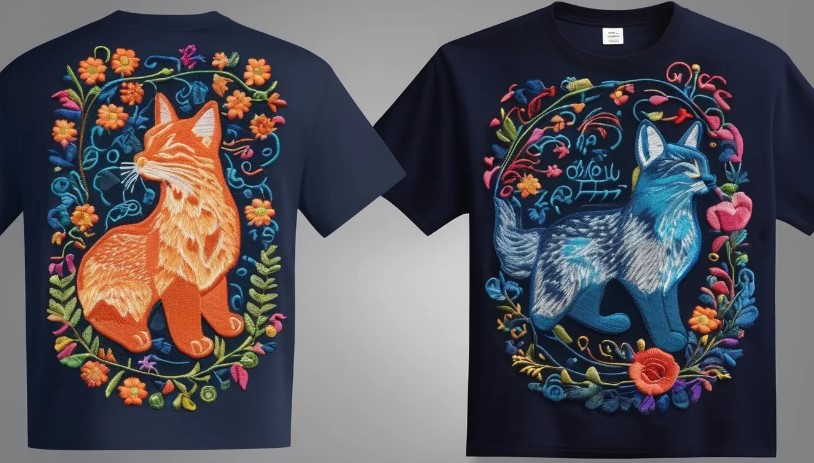In the world of embroidery, what truly transforms a design into a masterpiece is the meticulous process of digitizing. It’s the bridge that turns digital art into thread, giving logos, monograms, and artwork life on fabric. Whether it’s a corporate logo on a shirt, a creative design on a hat, or an intricate pattern on a jacket, embroidery digitizing is at the heart of it all. This article dives deep into how the process of transforming designs into precision stitch art not only ensures high-quality results but also brings creativity and business branding together with precision.
Why Embroidery Digitizing Matters: The Secret to Precision Stitch Art
Every thread count, stitch direction, and density is crucial when creating embroidery. Precision stitch art is achieved only when the digitizing process is done right. Here’s why digitizing is key:
- Accurate Representation of Design
A well-executed digitizing process ensures that every detail of your design is faithfully represented in the final embroidery. Whether your design is a logo with fine details or an intricate piece of art, proper digitizing allows the embroidery machine to reproduce it with complete accuracy. Without proper digitizing, even the most beautiful design can turn into a blurry, unprofessional result.
- Optimized Stitch Paths and Seamless Flow
Embroidery machines don’t sew designs in the same way a human would stitch by hand. Instead, they follow predetermined stitch paths, which must be optimized to ensure that the design is sewn efficiently and effectively. Digitizing involves creating the most efficient stitch path, which minimizes unnecessary movement of the embroidery machine and reduces thread breaks. It ensures that the stitches flow smoothly from one section to another, without disrupting the design.
- Fabric Compatibility
Each type of fabric behaves differently, whether it’s soft cotton, sturdy denim, or delicate silk. A crucial part of transforming designs into precision stitch art is selecting the correct stitch type and density for the fabric. Digitizing takes into account the type of fabric being used, adjusting the stitch density and underlay to ensure that the final product is durable and precise. Without this level of attention, designs could end up looking distorted or fragile.
- Scalability and Adaptability
What if the design needs to be scaled up for a large banner or scaled down for a tiny logo on a cuff? A skilled digitizer will ensure that no matter the size of the design, it remains crisp and clear. Scaling down a detailed design can often cause it to lose definition, but with proper digitizing, each stitch is strategically planned to retain clarity and visual appeal.
The Process of Transforming Designs into Precision Stitch Art
The digitizing process involves several key steps that together create a high-quality, professional result. Here’s a breakdown of how designs are transformed into precision stitch art:

- Design Review and Preparation
The first step involves reviewing the original design. The digitizer will look at the artwork and assess its complexity, colors, and style to determine the best approach. It’s during this phase that they decide which stitches are most appropriate for various areas of the design, such as satin stitches for clean, smooth lines or fill stitches for larger, solid areas.
- Conversion to Digital Format
Once the review is complete, the design is loaded into specialized embroidery digitizing software. This software converts the vector image or artwork into digital stitch instructions. The software allows the digitizer to control stitch type, stitch direction, underlaying, and density, ensuring the design is suited to the fabric and will withstand wear and tear.
- Optimizing Stitch Order and Direction
One of the most important aspects of embroidery is the stitch order. An unoptimized stitch order can lead to unnecessary thread cuts or stitches that overlap, causing a poor result. The digitizer carefully plans the stitch order to ensure that the embroidery machine works as efficiently as possible, minimizing interruptions and producing a flawless final piece.
- Choosing the Right Threads and Needles
The digitizing process isn’t just about the design; it’s also about the materials. Thread types and colors are chosen carefully to match the design, fabric, and overall aesthetic. Depending on the look desired, the digitizer may select threads of varying textures (such as metallic or matte) or weights to create the right visual effect. The appropriate needles are also selected to avoid damaging delicate fabrics or creating rough edges in the design.

Why Choose Professional Embroidery Digitizing?
Although digital embroidery tools are accessible, working with an experienced professional ensures that your designs are translated into precision stitch art correctly. Professional digitizers not only bring technical expertise but also a creative eye, ensuring that the final result is something that matches your vision while maintaining the integrity of the design. They bring experience in dealing with different fabrics, stitch types, and designs that a generic program or automated service might overlook.
Share this:
- Click to share on X (Opens in new window) X
- Click to share on LinkedIn (Opens in new window) LinkedIn
- Click to share on Tumblr (Opens in new window) Tumblr
- Click to share on Facebook (Opens in new window) Facebook
- Click to share on Pinterest (Opens in new window) Pinterest
- Click to share on WhatsApp (Opens in new window) WhatsApp
- Click to share on Reddit (Opens in new window) Reddit

